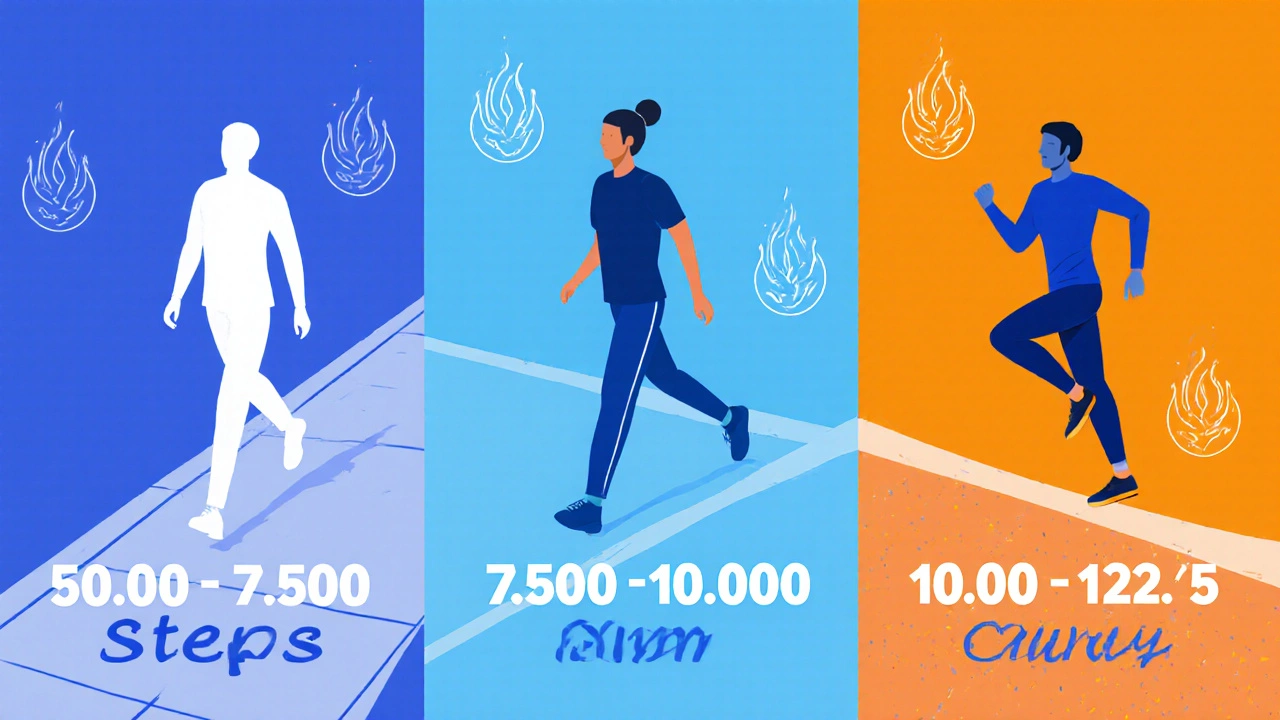Optimal Daily Steps for Weight Loss - How Many Do You Need?

Step-to-Weight Loss Calculator
Personalized Weight Loss Step Goal Calculator
Calculate your ideal daily step count for weight loss based on your body weight and desired weekly weight loss. This tool uses the science from our article to create a realistic goal.
People keep asking, "How many steps a day to lose weight?" The answer isn’t a single magic number - it depends on your body, your lifestyle, and the tools you use. In this guide we break down the science, walk you through realistic targets, and show how daily steps can become a reliable weapon in your weight‑loss arsenal.
What is a Daily step count?
A Daily step count is simply the total number of steps you take in a 24‑hour period. Modern smartphones, smartwatches, and dedicated pedometers record each footfall, turning an everyday activity into measurable data. When paired with a Fitness app, those numbers become a clear picture of how active you really are.
Why do steps matter for Weight loss?
Weight loss boils down to burning more calories than you consume - the classic Calorie deficit. Walking is a low‑impact cardio activity that burns calories while being easy on the joints. Each step uses a small amount of energy, but the total adds up quickly. For most adults, walking at a moderate pace (about 3 mph) burns roughly 0.04 calories per step. That means 10,000 steps translate to about 400 calories.
How many steps actually create a deficit?
The widely quoted 10,000‑step goal originated from a Japanese marketing campaign, not from scientific research. Real‑world studies show that a range of 5,000 to 12,500 steps can produce noticeable weight loss, provided you maintain a consistent deficit.
- 5,000 steps (~200cal) - Might maintain current weight for many people, but paired with a modest diet cut can tip the balance.
- 7,500 steps (~300cal) - Often enough to lose about 0.5lb per week if dietary intake stays constant.
- 10,000 steps (~400cal) - Common target for a steady 1lb loss per week when combined with a 500‑calorie diet reduction.
- 12,500 steps (~500cal) - Accelerates loss to 1.5lb per week for most adults.
Remember, these are averages. Your personal burn rate depends on a handful of key factors.
The variables that tweak the equation
Three main elements shift how many steps you need:
- Body weight & composition - Heavier individuals expend more energy per step because moving mass requires more effort. A 200‑lb person may burn 0.05cal per step, while a 130‑lb person burns about 0.03cal.
- Walking pace & terrain - Walking faster (3.5‑4mph) or on an incline raises calorie burn by up to 30%.
- Basal metabolic rate (BMR) - Your BMR is the calories you’d burn at rest. People with a higher BMR need a slightly smaller step count to achieve the same deficit.
All three can be monitored through a Fitness app that integrates a pedometer, heart‑rate monitor, and sometimes even a BMR calculator.

Choosing the right Fitness app for step tracking
Not every app measures steps accurately. Look for these features:
- Automatic step detection - Uses a built‑in accelerometer instead of manual entry.
- Calibration options - Lets you adjust step length based on height.
- Integration with heart‑rate monitors - Gives a better estimate of calories burned.
- Goal‑setting and reminders - Keeps you on track during the day.
Popular choices in 2025 include Apple Health, Google Fit, Fitbit, and the newer StepSync app, which syncs data across devices and offers a simple “Step‑Goal” widget.
Setting a realistic step goal - a step‑by‑step plan
- Calculate your maintenance calories - Use an online BMR calculator, then add activity factors. For a 30‑year‑old, 175‑lb male with a sedentary job, maintenance is about 2,400cal.
- Pick a target deficit - A 500‑calorie daily deficit leads to ~1lb loss per week.
- Translate the deficit into steps - If you plan to cut 250cal from food, you need to burn the other 250cal via walking. At 0.04cal/step, that’s 6,250 steps.
- Add your baseline activity - Most people already walk ~3,000 steps during daily chores. Subtract that from the target, leaving an extra 3,250 steps to add.
- Spread the steps - Aim for a 30‑minute walk (≈3,000 steps) in the morning, 15‑minute walk after lunch (≈1,500 steps), and a short evening stroll (≈500 steps).
- Track and adjust - Review weekly data in your app. If you’re consistently missing the target, increase your pace or add a quick 5‑minute hill walk.
Following this roadmap, you’ll hit a sustainable step count without feeling like you’re constantly counting calories.
Quick reference: step goals and estimated weekly weight loss
| Daily Steps | Avg. Calories Burned per Day | Weekly Calorie Deficit (incl. 250cal diet cut) | Estimated Weekly Weight Loss |
|---|---|---|---|
| 5,000 | ≈200cal | ≈1,650cal | ≈0.5lb |
| 7,500 | ≈300cal | ≈2,250cal | ≈0.6lb |
| 10,000 | ≈400cal | ≈2,850cal | ≈0.8lb |
| 12,500 | ≈500cal | ≈3,450cal | ≈1lb |
The table assumes a steady 250‑calorie diet reduction and an average walking pace. Adjust the numbers up or down based on your personal BMR and step intensity.

Common pitfalls and how to avoid them
- Relying solely on step count - If you walk fast, you’ll burn more calories than the table predicts. Pair steps with a heart‑rate monitor for a better estimate.
- Ignoring non‑step activity - Standing, fidgeting, and light household chores also contribute to daily energy expenditure.
- Overeating “reward” calories - Many people treat the extra steps as a free pass to indulge. Track food intake in the same app to stay honest.
- Skipping rest days - Too much walking can lead to fatigue or injury. Include 1‑2 lower‑step days each week to recover.
Putting it all together - your personalized action plan
- Download a reputable Fitness app that syncs with your phone or smartwatch.
- Enter your height, weight, age, and activity level to get a BMR estimate.
- Set a daily step goal based on the table above-start 2,000 steps above your current average.
- Schedule three dedicated walks (morning, lunch, evening) and log them immediately after each session.
- Adjust your food intake to create a modest 250‑calorie deficit.
- Review the weekly summary in your app; if you’re losing less than 0.5lb, bump the step goal by 500‑1,000 steps.
Stick with the plan for at least four weeks before judging its effectiveness. Consistency beats perfection every time.
Frequently Asked Questions
Do steps alone guarantee weight loss?
No. Steps create a calorie deficit, but if you eat back the same or more calories you’ll stay the same weight. Pair walking with a sensible diet for results.
Is 10,000 steps too much for beginners?
Not necessarily. Start with a goal 2,000 steps above your current average and increase gradually. Many beginners reach 10,000 after 3‑4 weeks without injury.
How accurate are smartphone step counters?
Modern phones use multi‑axis accelerometers and are usually within 5‑10% of a dedicated pedometer. Calibrate the app with your stride length for best results.
Can I lose weight by walking slower?
Walking slower burns fewer calories per step, but you can still lose weight if you increase total step count or cut more calories from food.
What role does the Basal metabolic rate play?
Your BMR is the baseline calories you burn at rest. Knowing it helps you set a realistic deficit-if your BMR is high, you may need fewer steps to lose the same amount of weight.